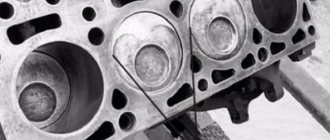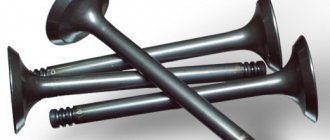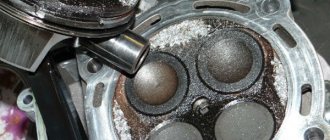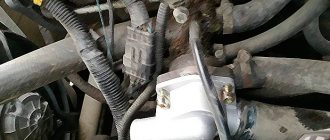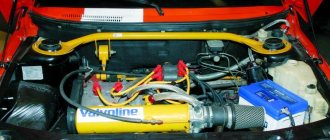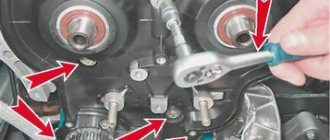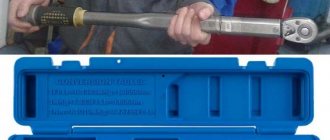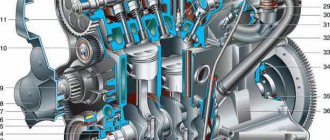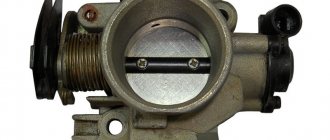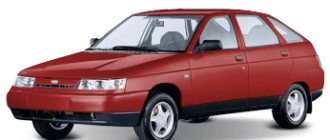The Lada of the tenth family in the hatchback body is the VAZ-2112 model. All cars of this family were produced until 2009. The range of engines included four options. Among them, by the way, were two 8-valve engines. Below we present the characteristics of 16-valve engines, but engines with 8 valves do not deserve attention. The torque graph proves these words true. So, let's look at the characteristics of VAZ-2112 engines with four valves per cylinder.
Two different 16-valve valves accelerate the car differently. Here is a video of the test drive.
Engine VAZ 21124-100026080. Characteristics of the VAZ 21124 engine.
The VAZ 21124 engine is a four-stroke, injection (distributed fuel injection), the placement of the cylinders in the block is single-row, the camshaft is located in the upper part of the internal combustion engine. The engine is cooled by forced circulation of liquid. Engine components are lubricated by supplying oil under pressure to the mechanisms and by splashing oil.
| Number of cylinders: | 4 |
| Cylinder displacement, l: | 1,599 |
| Compression ratio: | 10,3 |
| Rated power at a crankshaft speed of 5000 rpm: | 65.5 kW.-(89.1 hp) |
| Cylinder diameter, mm: | 82 |
| Piston stroke, mm: | 75,6 |
| Number of valves: | 16 |
| Minimum crankshaft speed, rpm: | 800-850 |
| Maximum torque at 3700 rpm, N*m: | 131 |
| Cylinder operating order: | 1-3-4-2 |
| Octane number of gasoline: | 95(unleaded) |
| Fuel supply system: | Electronically controlled distributed injection. |
| Spark plug: | AU17DVRM, BCPR6ES(NGK) |
| Weight, kg: | 121 |
Engine Features.
What kind of engine was installed: the VAZ 21124 engine can be used for installation on VAZ 2110, VAZ 2111, VAZ 2112 cars and their modifications.
Engine 21124 can be considered as a development option for the sixteen-valve internal combustion engine of the VAZ 2112. The purpose of the modification was to increase the volume to 1600 cm3 (2112 - 1500 cm3) and increase environmental performance to the requirements of European standards.
Cylinder block
The 21124 engine uses cylinder block 11193-1002011. Cylinder diameter – 82.0 mm. Structurally, it differs from the 2112 engine block in height (see “Cylinder block”). The height of block 11193 has increased and is 197.1 mm. (block height 2112 - 194.8 mm). The height of the block is considered to be the distance from the axis of rotation of the crankshaft to the upper surface of the block. The block is painted blue.
The difference between the new block and block 11183 is the use of a different size of holes for attaching the block head (block 11193 has threaded holes M10 x 1.25 mm). In addition, there is another difference, which is the presence of special nozzles pressed into the second, third, fourth and fifth main bearing supports and used to cool the piston crowns with oil while the engine is running.
The VAZ 21124 engine is equipped with a crankshaft 11183 -1005016. The same crankshaft is installed on the VAZ 21126 and VAZ 11194 models. The piston stroke of 75.6 mm is provided by a crankshaft crank with a radius of 37.8 mm. The crankshaft is marked. The inscription “11183” is cast on the sixth counterweight of the shaft.
To drive the gas distribution mechanism, a toothed pulley 2110-1005030 is installed on the crankshaft. The tooth profile of the pulley corresponds to the parabolic tooth of the timing belt. The engine uses a belt 2112-1006040 with a parabolic tooth (25.4 mm wide with 136 teeth). The belt resource is 45 thousand km.
A model 2112 damper is installed on the shaft. The damper performs several functions: through a poly-V-belt it drives the generator and other installed units; the special design of the pulley reduces the impact of torsional vibrations on the shaft; A timing gear located on the damper allows the sensor to determine the angle of rotation of the crankshaft.
Belts
On engines without additional attachments (without a power steering pump and without an air conditioning compressor), a serpentine alternator belt 2110-3701720 6RK742 (742mm) is used.
On engine 21124 with a power steering pump installed, there is a poly V-belt 2110 -1041020 6РК1115 (1115mm).
On the model with an air conditioning compressor - belt 2110-8114096 6РК1125(1125mm).
Piston
New pistons mod are installed on the engine. 21124. The piston is marked accordingly. Compared to the 2112 piston, this piston has a difference. On the bottom of the piston there are four holes for valves. The holes are made with a depth of 5.53 mm. Wells of this depth help prevent contact of the valves with the piston in the event of a timing belt break. On pistons 2112, the wells have a shallower depth: 3.19 mm for the intake and 3.06 for the exhaust.
Rings
Sets of normal size rings of 82 mm are used: 21083-1000100-10 – cast iron or 21083-1004029 – steel rings.
The diameter of the piston pin 21124 is 22 mm, the length of the pin is 60.5 mm. The pin in the piston is installed with a floating fit. Axial fixation is carried out by locking rings.
Connecting rods and pins from a 2110 engine.
Head
The sixteen-valve cylinder head of the 21124 engine differs from the 2112 cylinder head only in the larger surface area for joining the intake manifold flanges. Two camshafts are installed at the top of the head: one for the intake valves, the other for the exhaust valves. The camshafts, valves, springs and hydraulic lifters remain from the 2112 model. The intake and exhaust camshafts have special marks. The intake camshaft has a raw shoulder near the first cam. In addition, between the second and third cams of the shaft there is a marking in the form of numbers, where the last two digits are “15”. There is no belt on the exhaust camshaft, and the last digits of the number will be “14”.
The installation of hydraulic pushers made it possible to avoid adjusting the gaps in the valve mechanisms. But the hydraulic pusher mechanism is very sensitive to the quality of the oil and its purity. Presence of fur in oil. impurities can lead to failure of the hydraulic pusher. Hydraulic pushers cannot be repaired - they need to be replaced.
The VAZ-21124 cylinder head contains model 2112 valves. The valves have a smaller diameter stem. -7mm (8mm for eight-valve engines). There is only one spring installed on each valve.
The camshafts are driven by a toothed belt from the crankshaft. A toothed pulley is installed on each of the camshafts. The marks for setting the valve timing on toothed pulleys 21124 are made with an offset of 2 degrees relative to similar marks on the pulleys of the VAZ-2112 engine.
Toothed pulleys are different and have their own markings. Intake pulley 21124-1006019 is marked with a circle near the hub and has a welded shutter on the inside of the pulley. Exhaust pulley 21124-100606020 has a similar marking, but without a shutter.
Tuning
Simple firmware or chip tuning for 124 engines not the technical characteristics . To significantly increase power, it is necessary to modify the engine.
- The simplest and most common tuning of the 21124 engine is the installation of sports camshafts, a direct-flow resonator, an increased throttle - in this way you can increase the power to 120 hp. Installing a lighter piston engine can add some power to this. This, at the same time, will reduce the fuel consumption of the VAZ 21124.
- About 150 hp can be ensured by modification of the cylinder head and installation of camshafts with increased valve opening phases.
- Installing a compressor has approximately the same effect; it is installed on eight-valve and sixteen-valve engines.
- Stable engine operation at any speed is ensured by installing four chokes, one for each cylinder. According to popular experience, the most suitable option is to install an injection system from ToyotaLevin. To do this, a set is assembled from the chokes themselves, an adapter manifold, a zero-resistance filter, injectors, an absolute pressure sensor and a fuel pressure regulator. Due to the fact that the speed exceeds the limit, it is necessary to install lightweight piston and wide-phase camshafts. With this modification, engine power can reach 200 hp. But such modernization sharply reduces the service life of the engine, is fraught with frequent breakdowns and the need to carry out serious repairs of the VAZ 124, due to the fact that the engine easily and often spins up to 9,000 rpm.
Advantages of a sixteen-valve engine
We have already said that the internal combustion engines of the VAZ-2110 (2112) family discussed in the article are distinguished by greater power, lower fuel consumption, and also high technical characteristics, unlike the V8s. It's time to find out what design features make the VAZ 2112 16 valve engine such an attractive choice for motorists.
Let’s immediately make a reservation about exactly what “advantages” will be discussed in this section of the article:
- fuel economy;
- higher power;
- detonation resistance;
- advanced cooling system;
- simple tuning due to the separation of the intake and exhaust tracts.
It is the separation between the intake and exhaust tracts in the design of the VAZ-21120 and 21124 engines that makes it possible to achieve quite noticeable fuel savings. Thus, the supply of fuel and the intake of exhaust gases is carried out by a separate spaced valve system, due to which there is no unwanted mixing of fuel and combustion products. It is also obvious that this increases the efficiency of the engine and its power.
Sixteen-valve VAZ 2110 engine
The innovations did not ignore the combustion chamber, as well as the structure of the cylinder block. Their design is slightly modified in such a way that the risk of detonation of the fuel mixture is minimized. This is truly a significant advantage, because the quality of gasoline in our gas stations leaves much to be desired. Accordingly, this kind of internal combustion engine design remains a guarantee of its long service life.
The operation of the cooling system of such devices is also pleasing with high stability. This is the most important factor ensuring long engine operation and reliability during its operation. Effective heat removal allows the internal combustion engine to operate at a given temperature, preventing premature wear. Are the benefits of 16 valves significant enough for you? But that is not all.
Some conclusions
The steel receiver looks powerful and beautiful
All VAZ-2112 hatchback engines differ in characteristics, and the differences are significant. It seems that the best option would be a 16-valve 1.5-liter engine. But the 21124 (1.6) engine has its advantages:
- Rated power is achieved at 5000 rpm rather than 5600;
- A broken timing belt does not lead to bending of the valves and their replacement;
- It is acceptable to use 92nd gasoline.
Any 21124 engine can be converted to Euro-4 or meets these standards immediately.
The appearance of the 1.5 liter engine inspires respect. But if you remember about bending the valves, the choice becomes difficult to make. A steel receiver and a beautiful schedule are not everything.
Various nuances
Motor 21124 is more modern than its brother. It has spark plugs with individual coils installed on it. Experienced craftsmen also know about the tuning possibilities specific to the 21120 engine (for example, installing a turbine). In defense of the latter, we can say the following: the service life of the two engines under consideration is approximately the same. After the first 120 thousand, the 20th engine deserves a rating of “4.5 out of 5”.
On the secondary market, VAZ-21120 and 21126 (Priora) engines are valued almost equally. But the VAZ-21124 unit is in short supply. Draw conclusions.
Tuning of the internal combustion engine cylinder block, conversion of the 8 valve VAZ-2110 (2112) engine to 16 valve.
Tell me, after reading all the above-mentioned information, are you not inspired by the idea of having a car with 16 internal combustion engine valves? In this case, you will be pleased to know that this kind of modernization is allowed. Of course, this process is thorough and cannot be completed without careful preparation. But the result will really justify itself. If you have any doubts, just read the next few paragraphs of the text.
Without going into technical details, the essence of tuning is to replace the cylinder head with a new one. Of course, now you will have two camshafts, and you will also have to rack your brains over the fastening system, because the diameters of the holes in the 16 valve head do not correspond to those on the 8 valve head.
The mounting holes of the block head should be drilled, increasing the diameter from 10 to 12 millimeters.
You can do this yourself, but it is better to contact a specialized workshop. For this kind of work they should not charge more than 3-4 hundred rubles. It should also be taken into account that the standard mounting bolt for the 16-valve cylinder block is slightly smaller than that for the “eight” and must be shortened accordingly.
It is better to study in advance what a 16-valve engine is like on a VAZ 2110 and then you will certainly be able to carry out this kind of tuning yourself. It will be necessary to change the timing belt, pump pump, rollers, wiring, spark plugs, connecting rod mechanism and other structural elements due to the peculiarity of the cylinder head. The head is assembled separately before installation on the engine. After completing the work, it is also advisable to use specialized services for setting up and calibrating the operation of the internal combustion engine.
Tuning the exhaust manifold (spider)
Replacing the standard exhaust manifold with an alternative type “Spider” 4-1 or 4-2-1 is a fairly effective and at the same time cheap way to significantly increase the power of your VAZ-2110 car. This part costs about 2000 rubles. When purchasing, you should clarify which car models the product is intended for.
Thanks for subscribing!
Exhaust manifold 4-2-1
The “Spider” sports exhaust manifold for VAZ-2110 (2112) cars is considered more technologically advanced, providing the most efficient removal of exhaust gases from the internal combustion engine. In addition, it is recommended to purchase an additional direct-flow type resonator and a muffler for it. This way you can avoid welding work and significantly simplify the tuning task.
The replacement process is relatively long and will take you about 4 hours; it is also advisable to carry out the work with someone else’s help, this greatly facilitates and speeds it up. You will need to remove the stock exhaust manifold and exhaust pipe. You can dismantle them as an assembly. After installing the “spider”, the replacement process can be considered complete.
How to avoid costly repairs to the internal combustion engine and cylinder block if the timing belt breaks
A broken timing belt can cause a really expensive repair. If your car suddenly stalls due to a broken belt, you can be sure that expensive repairs are guaranteed (if you have a VAZ 2112 engine 16 valve type 21120). Restoring bent cylinder head valves will cost the motorist about 10 thousand rubles. So what to do? There is a completely rational way to avoid misfortune.
The cause of the trouble can be considered to be imperfect engine design. In order to avoid the problem, on a VAZ-21124 type engine there are special recesses (countersets) on the pistons, thanks to which the valves do not bend against the pistons, encountering them when the timing belt breaks. On the earlier model of the 16 valve engine (21120), released two years earlier (in 2002), such notches, alas, are absent.
Otherwise, it’s not a big deal and you can insure yourself against misfortune by making the appropriate holes yourself, for example, during a major overhaul of the engine, or by specially disassembling it and removing the pistons from the cylinders. It will be enough to increase the depth of the counterbores by 2.5 mm. work is performed using a milling machine.
Pistons of the VAZ 21124 cylinder block
If you are afraid of the need to thoroughly disassemble the internal combustion engine, there is a simpler method thanks to the special PP-12 device. Now you just need to remove the cylinder head and you can perform milling by reading the operating instructions for the device. However, this device is far from cheap, so it would be best to seek help from a specialized workshop, where they will carry out all the necessary work.
At the same time, the size of the combustion chamber increases slightly and the compression ratio decreases. We receive a derated VAZ-2110 engine. The power of the internal combustion engine drops somewhat. On the other hand, performance characteristics are increased, and now the car can be filled with 92 gasoline and not worry about a torn timing belt. Agree, the benefits definitely pay for the costs.
The VAZ-21124 engine is a 16-valve representative of the line of power units produced by AvtoVAZ JSC since 2004. In fact, this model was the result of another improvement of the VAZ-2112 engine and was installed on production cars: VAZ-21104, 21114, 21123 “Coupe”, 21124, 211440-24. Later it was used to create more powerful units: VAZ-21126 and VAZ-21128 engines produced by the Super-Auto production enterprise.
Engine characteristics 21124
In general, the power unit remained quite traditional, that is, four-stroke, with one row of cylinders, overhead camshafts and distributed fuel injection (injector).
- Cooling is forced, air-liquid.
- Cylinder volume – 1599 cm3.
- The cylinder operation is standard – 1-3-4-2.
- Power at 3800 rpm. – 98 l/s.
- The number of valves is 16 (four for each cylinder).
- The diameter of the cylinder bottom is 82 mm.
- The piston stroke length is 75.6 mm.
- The compression ratio of the mixture is 10.3.
- The minimum crankshaft rotation speed is 800-850 rpm.
- The recommended brand of gasoline is AI-95.
- Fuel consumption: in the city - 8.9 l, on the highway - 6.4 l, in mixed mode - 7.5 l (distance 100 km).
- The working volume of the oil sump is 3.5 liters.
- Weight – 121 kg.
- The technical life of the 21124 engine before the first overhaul, declared by the car plant, is 150 thousand km (in practice, the car is capable of traveling 100 thousand km more).
Description
The VAZ 21124 engine is part of the line of 16-valve power units produced by AvtoVAZ JSC. It is an in-line 4-cylinder unit with overhead camshafts and electric fuel injection (injector).
The gas distribution mechanism is driven by a belt, which needs to be changed after any 45,000 km. With all this, the manufacturer advises inspecting it for damage and eliminating sagging any 15 thousand km of the distance traveled.
The VAZ 21124 engine is assembled on the basis of the highest (197.1 mm) cylinder block modification 11193-1002011, the introduction of which made it possible to increase the piston stroke to 75.6 mm. This led to an increase in the useful cylinder size to 1.6 liters, torque and power of the unit.
The developers of motor 21124 managed to remove a significant defect inherent in almost all motors. If the drive belt breaks, the unit does not bend the valve. This was achieved by equipping the pistons with special holes that prevent contact between the piston and the valve in an emergency.
The introduction of hydraulic pushers made it possible to abandon the need to regulate valve mechanism clearances. True, with all this, the sensitivity of the engine to the quality of engine oil has increased.
The features of the VAZ 21124 engine also include:
- absence of high-voltage wires. Instead, a separate ignition coil was installed on each spark plug;
- the presence of special nozzles designed to cool the piston bottoms. They are pressed into bearing supports.
Drive belts used in the engine and their markings
To operate the timing mechanism, the design of the 16-valve 21124 engine uses a 25.4 mm wide belt, which has 136 parabolic teeth and is marked “2112-1006040”. The service life before possible replacement is 45 thousand km.
If additional attachments are not installed on the engine, namely the power steering pump and the air conditioning compressor, then the generator drive uses a belt marked “2110-3701720 6 PK 742” (working length - 742 mm).
If a power steering pump is installed, then a belt of a different size is installed to drive the generator - 1115 mm. Its marking is “2110-1041020 6 PK 1115”.
The model with an air conditioning compressor has an even longer alternator belt – 1125 mm, marked “2110-8114096 6 PK 1125”.
Technical service
Technical service of VAZ 21124 engines generally comes down to repeated replacement of consumables - engine oil and cooling water.
The main requirement that needs to be done is to inspect the engine for leaks. Typically, replacement of technical fluids is carried out after eliminating the found leaks within the time limits discussed in the maintenance regulations:
- engine oil - after 15,000 km;
- The coolant is changed if it has completely changed its original color. Typically, the coolant acquires a rust color after 25-40 thousand km. Before replacing, it is better to wash the cooling system.
Features of the piston group
The updated engine also received new pistons, in the bottom of which there are valve wells: four recesses 5.53 mm deep are made in each piston, which are designed to prevent bending (breakage) of the valves in the event of a timing belt break.
Previously, if this happened, the connection between the valves and the crankshaft was lost, their movement stopped, but the shaft itself, carried by the flywheel, continued to rotate by inertia, and accordingly, the pistons moved. As a result, they collided with the valves. The result is that they bend, break, or even pierce the bottom of the piston.
The dimensions of the piston rings, which can be either cast iron or steel, remain the same: 82 mm.
The piston pin has a floating fit, and its axial fixation is ensured by retaining rings. The length of the finger is 60.5 mm, and its diameter is 22 mm.
The 21124 engine connecting rods are interchangeable with the 2112 connecting rods.
Cylinder head
The sixteen-valve cylinder head differs from the one installed on the 2112 only in the increased surface area allocated for mounting the intake manifold flanges.
To control the valves, two camshafts are installed in the upper part of the cylinder head: one for the intake group, the other for the exhaust group. To distinguish them, the manufacturer places marks that are located on the shaft journal behind the second cam. If the last number is 14, then it is an exhaust shaft, if it is 15, then it is an intake shaft. In addition, the intake camshaft has a raw metal band near the first cam.
Since the head is equipped with hydraulic pushers, this saves the car owner from adjusting the thermal gaps between the cams and valves.
However, such convenience forces the driver to carefully monitor the cleanliness and quality of the oil, since the hydraulic pusher mechanism is very sensitive to foreign impurities in the lubricant, the presence of which can lead to its failure, and it cannot be repaired, only completely replaced.
The valve stems of a sixteen-valve engine have a diameter of 7 mm, while for an eight-valve engine they are 1 mm larger.
As mentioned above, the camshafts rotate thanks to a belt drive coming from the crankshaft. The marks for correct setting of the engine operating phases on pulleys 21124 are offset by two degrees relative to the same marks placed on the pulleys of the power unit 2112.
The toothed pulleys of the intake and exhaust shafts differ from each other and are marked with their markings: intake - “21124-1006019”, exhaust - “21124-100606020”. In addition, the inlet pulley has a circle near the hub and a curtain on the inside; the exhaust pulley does not have such a curtain.
Features of the fuel system and ignition system
First of all, it should be noted that the VAZ-21124 uses a new type of fuel rail, made of a stainless alloy and different from the one on the VAZ-2112, primarily in that there is no drain line in the fuel system. The required gasoline pressure in the line is maintained by a special valve installed in the fuel pump.
As for the ignition system, what is special about it is that high-voltage wires were excluded from its design. The fact is that on the 21124 engine, each spark plug received a separate ignition coil.
The coils are fixed directly to the spark plugs and, in addition, have an additional attachment to the cylinder head cover. Thanks to this innovation, the reliability and efficiency of the ignition system has increased significantly.
Malfunctions
VAZ 21124 engines have the same set of corresponding shortcomings that are characteristic of all VAZ engines. The most common are:
| FAULTS | CAUSES | REMEDY METHODS |
| The engine runs erratically or stalls at idle. | Ÿ Broken idle speed sensor. Air leaks through the crankcase ventilation hoses and the hose connecting the intake manifold and the vacuum brake booster. | Ÿ Change the idle speed sensor; replace damaged hoses; Ÿ tighten the hose clamps. If this does not help, check the serviceability of the fuel injection system. |
| The motor does not develop full power. | Ÿ The throttle valve does not open fully. Ÿ Broken throttle sensor. Ÿ The air filter is clogged. Bad fuel. | Ÿ Adjust the throttle valve drive; Ÿ change the faulty sensor; Ÿ change the air filter. |
| Increased fuel consumption. | Ÿ Ÿ Fuel leaks in connections. Ÿ Broken injectors and/or ignition system. Increased resistance to vehicle movement. | Ÿ Fill with high-quality fuel; Ÿ check and, if necessary, tighten the fastening clamps. Replace damaged parts; check the operation of the engine control system and fuel injection; Ÿ check the alignment of the front wheels, the operation of the brake system and the tire pressure. |
Engine operating temperature 21124
Many car owners of VAZ car models know that the operating temperature of the engine is considered to be 90 degrees Celsius. However, with the advent of 16-valve engines of the VAZ-2112 series, this norm became less clear. The fact is that with the introduction of environmental requirements, the engines were modernized, and in connection with this, the manufacturer also changed the temperature range for them. Now engine temperature fluctuations within the range of 87–103 degrees are considered normal.
In conclusion, it should be mentioned that the 21124 engine oil must have a viscosity of 5w30, 5w40, 10w-40 or 15w-40. A dry motor contains 3.5 liters of lubricating fluid, but after draining, about 800 grams remains in the crankcase; accordingly, when replaced again, the volume filled will decrease.
Table of fuel costs for VAZ brands.
The table describes the average costs for various VAZ brands . Fuel consumption is presented in 3 types - city, highway and mixed (average) fuel consumption. All data on fuel costs are from the VAZ car manufacturer. In fact, for all brands of VAZ cars, fuel consumption does not exceed 10 liters. per 100 km, except for the carburetor Niva.
Average fuel consumption VAZ
liter/100 km
120 km/h=10
120 km/h=9.8
| Brand VAZ | Power, hp | City | Route | |
| VAZ 2101 (1.2, carburetor) | – | 10.5 | 11 | |
| VAZ 2102, 2103 (1.5, Carburetor) | 71 | 11 | 11.5 | |
| 2106 (1.57 engine, carburetor, 4-speed gearbox) | 76.4 | 9.5 | 10.5 | 8.5 |
| 2106 (1.45 engine, carburetor, 4-speed gearbox (Checkpoint - a point designed to control passage (visit) and access to the territory of any facility) ) | 73.5 | 9.9 | 10.8 | 9.0 |
| 2106 (engine 1.6, injector) | – | 8.4 | 9.8 | 7 |
| 2105 (1.3, carburetor) | 64 | 9.1 | 10.2 | 8.1 |
| 2105 (1.5, carburetor, 4-speed gearbox (Checkpoint - a point designed to control passage (visit) and access to the territory of any facility) ) | 71.1 | 8.8 | 9.5 | 8.0 |
| 2107 (1.6, injector) | – | 7.8-9.8 | 9-11.5 | 6.7-8.2 |
| 2107 (1.6, carburetor) | – | 8.9 | 10.2 | 7.5 |
| 2107 (1.5, carburetor) | – | 8.3 | 9.6 | 7.0 |
| 2108, 2109, 21099 (1.5, carburetor) | 72 | 9.1 | 10.1 | 8.2 |
| 21083, 21093, (1.5, injector) | 72 | 7.6 | 8.5 | 6.7 |
| 2110, 2111, 2112 (1.5, carburetor) | 67.7 | 9.5 | 10.5 | 8.4 |
| 2110, 2111, 21124 (1.5, injector) | 72 | 7.9 | 8.7 | 7.0 |
| 2113, 2114, 2115 (1.5, injector) | 72 | 7.6 | 8.5 | 6.7 |
| Lada Granta (8 valve) | 80 | 7.0 | 8.3 | 5.8 |
| Lada Granta (8 valve) | 90 | 7.7 | 9.3 | 6.1 |
| Lada Granta (16 valve) | 98, 106, 120 | 8.1-10.1 | 9.2-11.2 | 7-9 |
| Lada Kalina 21117, 21118, 21119 (1.4 engine) | – | 6.9 | 7.8 | 6.0 |
| Lada Kalina 21118, 21119 (engine 1.6) | – | 7.2 | 8.1 | 6.3 |
| Lada Priora (1.6) | 90 | 7.6 | 8.8 | 6.5 |
| Lada Priora (1.6, 16 valve) | 106 | 8.6 | 9.5 | 7.7 |
| Lada Vesta 21179 (1.8, 16 valve) | 123 | 8.5-10.5 | 9.5-11.5 | 7.5-9.5 |
| Lada Vesta 21129 (1.6, 16 valve) | 106 | 8-10 | 9.0-11.0 | 7.0-9.0 |
| Lada x-Ray (X-ray, 1.6, 16 valves) | 110 | 7.9 | 8.8 | 7.0 |
| Lada x-Ray (X-ray, 1.8, 16 valves) | 122 | 8.1 | 9.1 | 7.2 |
| Lada Largus (1.6, 8 valve) | 90 | 8.6 | 9.5 | 7.7 |
| Lada Largus (1.6, 16 valve) | 105 | 8.2 | 9.0 | 7.5 |
| VAZ 21213 (Niva, 1.7, carburetor) | – | 11.5 | 13.0 | 10.0 |
| VAZ 21214 (Niva, 1.7, injector) | – | 9.8 | 11.0 | 8.5 |
| VAZ 2131 (Niva, 1.8, injector) | – | 11.1 | 12.8 | 9.5 |
VAZ has acceptable fuel consumption!
The car is given excellent dynamism and acceptable fuel consumption thanks to its reliable engine. VAZ has an affordable price for both the newest and old cars. Old VAZ brands are suitable for most people. The latest VAZ engine shows maximum efficiency, thanks to which the car has low fuel consumption and the level of harmful emissions into the atmosphere is reduced.
VAZ is an average car quality, affordable price and acceptable fuel consumption.
